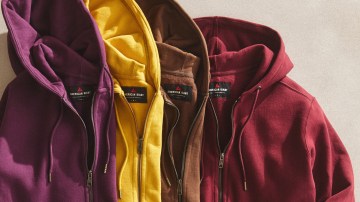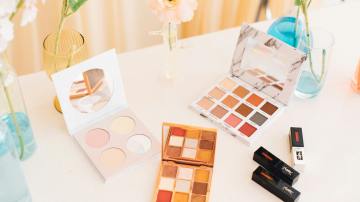In this week’s luxury briefing, a deep dive into why beauty is leading the charge for Victoria Beckham, and why it could lead to a buyout. Also, news to know and Glossy’s podcast featuring Vicky Picca, president of sports fashion brand Off Season. For tips or comments, email me at zofia@glossy.co.
On Tuesday, Victoria Beckham Holdings Ltd. reported 2024 revenues of £112.7 million ($146 million), up 26% from 2023. EBITDA grew 22% to £2.2 million ($2.9 million), or 47% when excluding the fragrance line launched in late 2023. It was the group’s fourth consecutive year of double-digit growth.
Much of that success is anchored in Victoria Beckham Beauty, launched in September 2019. In 2024, beauty accounted for an estimated 40-45% of Victoria Beckham Holdings’s £112.7 million ($146 million) in sales, according to data platform Luxurynsight, up from around 20% in 2022. Fashion — led by dresses, leather goods and denim — grew modestly, while beauty drove the bulk of the company’s 26% topline increase. The company does not break out its sales by business.
The beauty brand’s Satin Kajal Liner, introduced in November 2019, has become the breakout hero, with one selling every 30 seconds. New launches have built on that momentum: 2024 marked the launch of a double-cleanser and a concealer pen created with Augustinus Bader, while the fragrance arm expanded with 21:50 Rêverie — the brand’s follow-up to its fragrance debut, Portofino ’97, in 2023. A foundation launch, set for later this year, is expected to boost complexion products’ sales to more than 20% of the business by the end of 2025. Distribution is also widening, with 130 new retail doors planned for the brand’s beauty line, bringing the total to 200 across 50 countries. The brand did not respond in time for publication.
Jonathan Siboni, founder and CEO of luxury data platform Luxurynsight, called this a deliberately measured rollout. “They’re not chasing 60% growth and risking burnout,” he said. “Instead, they’re building steadily at 15–20% a year, which creates lasting value. Once you have a hero like the eyeliner, you can scale from £20 million ($26 million) to £50 million ($65 million), something fashion alone rarely delivers.”
“From a business perspective, leading with beauty makes perfect sense,” he said. “Fashion is difficult to scale profitably, but beauty has higher margins, faster repeat purchase [rates] and greater stability. If Victoria Beckham wants long-term growth, or even to prepare for a sale — beauty is the smart way in.”
“Luxury beauty generally outperforms fashion on volume, profitability and repeat sales, so unit metrics, like how many eyeliners or fragrances are sold, are often the clearest signal that beauty is driving growth,” said Marissa Lepor, managing director at financial advisory The Sage Group.
In June 2023, Kering acquired fragrance house Creed for €3.5 billion ($3.8 billion), betting on its enduring profitability and brand equity. The acquisition underscored just how valuable beauty can be on its own, with the 260-year-old fragrance house valued at more than some mid-sized fashion labels.
And, Siboni added, “It’s more bankable to sell a beauty brand with a fashion division than the reverse.”
Victoria Beckham Beauty has already taken key steps to grow its visibility. In July 2025, it entered 20 Space NK stores in the U.K. and SpaceNK.com, extending beyond direct-to-consumer. The same month, Ulta Beauty acquired Space NK to accelerate its international expansion. The deal was estimated at above £300 million ($390 million–$408 million).
That distribution footprint and brand discipline make Beckham a potential target for a group like Puig, according to Siboni. The Spanish luxury house, which acquired Charlotte Tilbury for around £1.3 billion ($1.6 billion) in 2020 and Byredo for close to €1 billion ($1.1 billion) in 2022, has a track record of betting on fashion-beauty hybrids like Jean Paul Gaultier, Carolina Herrera, Paco Rabanne and Dries Van Noten, brands where beauty has become as central as fashion. “VB fits that profile perfectly,” Siboni said.
However, even as beauty accelerates, fashion remains a core focus of the company. Victoria Beckham, launched in 2008, grew in 2024 through sales of denim, handbags and crepe dresses. To date, it has earned visibility by being worn by the Princess of Wales and Michelle Obama. Yet, its long-term role is unclear.
“The clothes are beautifully made, but the question is what the line ultimately stands for,” said Melissa Roth Mendéz, founder of MRM Advisory and former vp of Burberry. “Luxury houses usually anchor themselves in codes that outlast any one founder. Fashion is still closely tied to Victoria herself, which works in beauty but limits permanence in fashion.”
Still, the brand is increasingly demonstrating smart merchandising. Erin Mullaney, luxury consultant and former Browns fashion director, said the Victoria Beckham brand’s recent pre-fall and fall collections are more cohesive than earlier seasons, with stronger color stories and pricing that is more competitive than two or three years ago. Dresses remain bestsellers, while knitwear, denim and handbags are rising categories. “Beckham’s fans want a piece of her lifestyle,” Mullaney added, suggesting wellness or activewear could be natural category additions for the brand.
“The risk comes if beauty becomes a substitute for fashion rather than a complement; long-term investor confidence depends on a brand showing scale, profitability and customer engagement across categories, not just one,” said Lepor.
For Pierre Vouard, principal at PJV Advisory and former Shiseido executive, the dynamic is clear: “For Victoria Beckham, fashion profitability has been a challenge. Beauty, with stronger margins and a DTC-led model, supports the balance sheet.”
He added, “What’s striking is how carefully VB has expanded — the storytelling feels closer to Chanel, Dior or Tom Ford than a typical celebrity brand.”
Other brands have walked a similar path. In 2024, Puig’s Fragrance & Fashion segment — which includes Paco Rabanne, Carolina Herrera and Jean Paul Gaultier — generated about €3.54 billion ($3.75 billion), or 73% of total revenue, according to earnings released in March. The company does not break out fashion separately, but analysts estimate the category represents only about 10% of the figure, with fragrance providing the overwhelming majority. Fragrance can serve as a financial backbone for a fashion-beauty company, providing the repeatable, high-margin sales that often outstrip fashion — a model Victoria Beckham now appears to be following.
“Over time, houses evolve from person to persona, becoming cultural entities,” Siboni said, noting how Yves Saint Laurent became Saint Laurent and Paco Rabanne recently rebranded to Rabanne. For Victoria Beckham, the challenge is whether the brand can eventually transcend Beckham’s persona in the same way, ensuring its longevity beyond the founder on both sides of the business.
Dolce & Gabbana offers one model: After decades of licensing, it brought beauty in-house in 2022, and by 2024, it was generating €600 million ($660 million), or 35% of group sales. Another luxury British brand, Burberry, by contrast, tried to build its own division in 2013 but retreated to licensing with Coty by 2017. While keeping control of beauty can be transformative, it is also resource-intensive and risky.
As luxury demand softens, Beckham’s independent growth is unusual. Few celebrity-led brands reach £100 million ($130 million) in sales, and fewer still balance fashion and beauty without a conglomerate. Whether the future brings continued independence or an acquisition, the model is proving resilient. Beauty has given the brand a foundation for stability. The challenge now is ensuring fashion becomes more than an accessory to that success.
News to know
- This year’s U.S. Open, running from August 25 to September 7, has doubled as a fashion showcase: On the court, tennis player Venus Williams has worn custom looks by Khaite and Luar, Coco Gauff has debuted her Miu Miu x New Balance collaboration, Jessica Pegula has sported Y-3, and Taylor Townsend has flaunted her own TT label. Off the court. Burberry hosted a star-studded, pre-tournament dinner in Soho.
- Antler has acquired the sustainable luggage brand Paravel to form a “House of Travel Brands,” targeting £100 million ($128 million) in sales by 2029.
- Maison Margiela has launched Line 2, a new category of “intangible products” debuting September 3 with an art installation in Seoul.
- Kering will hold its combined general meeting on September 9, the first since its governance overhaul and CEO change.
Listen in
On this week’s Glossy Podcast, senior fashion reporter Danny Parisi and international reporter Zofia Zwieglinska unpack the biggest industry stories, including Ricardo Bellini’s appointment as CEO of Valentino and the implications for the brand’s direction, Authentic Brands Group’s acquisition of Guess, and TJX’s strong earnings results, which point to ongoing strength in discount retail. Later, editor-in-chief Jill Manoff shares a conversation from our Sports Opportunity digital event with Vicky Picca, president of Off Season, the sports fashion label co-founded by designer Kristin Juszczyk and Skims’s Emma Grede. With a background as svp of business affairs at Fanatics, Picca brings deep sports expertise to Off Season, which she joined in April.
Read on Glossy
Behind the scenes of the Aritzia x Sperry collaboration. TJX to open 1,800 new stores. Brands are betting on bridal resale. Essie’s Ellie the Elephant success.




